One Summer’s Paddling: Circumnavigation
Circumnavigating Kangaroo Island, 21 December–12 January
‘I don’t suppose I can stop you fellows now.’ The police sergeant was not happy. Before him were people with plans to do something that had never been done before, no less than a complete circumnavigation of Kangaroo Island, Australia’s second largest island: by kayak.
It would be too easy, and totally wrong, to criticise his attitude. After all, part of his responsibilities include, at times, having literally to pick up the pieces of broken boats, cars, aircraft, and people. He didn’t want four more. We explained that we had planned carefully, that we had all the necessary equipment and knew how to use it, that we had made arrangements to communicate through the fishing cooperative network and promised to keep him advised of our progress.
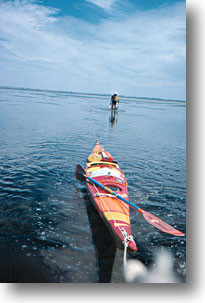
Months of planning and organising were put into effect at about 14:00 on December 21 1980, as we launched from the beach at Kingscote, passed the jetty for the local paper’s editor to take pictures, and headed north across the Bay of Shoals. Before long we were walking again, towing our heavily laden boats behind us across the shoal. Leaving Kingscote at low tide was not such a good idea. [John in background of pic]
The four of us made an assorted crew1. John Hicks and I were both teachers, although John has had many other interesting jobs elsewhere in the world. David Nicolson and Mike Higginson were both ‘outdoor’ workers, David for a climbing equipment supplier and Mike was then an instructor for Outward Bound. David and John, both very experienced in the outdoors, were making their first major kayak expedition, but Mike, besides being a very competent surf paddler, had been a member of a 1978 British kayak expedition down the River Nile. You can read of one of my earlier expeditions in the July 1979 issue of Outdoors2.
That night we camped on the beach at Boxing Bay. Among the flotsam on the beach was a length of very heavy hawser. It would have been good for a tug of war, with the first team to manage to pick it up becoming the winner. During the night there might well have been more items of flotsam as the tide rose higher than the previous one. When John woke next morning he wondered why his boat had come to be above him, not below, on the beach.
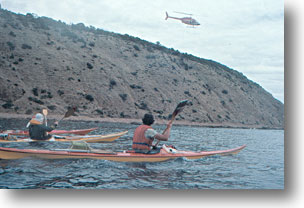
The forecast3 warned of a change, and included a Strong Wind Warning4. We decided to leave as soon as possible, but by late morning found ourselves with a headwind of some 25 kn, making the going heavy. We landed for lunch at Dashwood Bay, where some fishermen were calling it a day. During lunch there came the sound of an approaching helicopter. It circled us and landed, bringing a television crew and journalists, who somehow managed to get my name wrong, even though I wrote for their paper5.
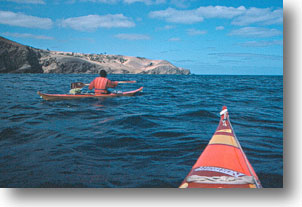
While others were reading about us on page three the next morning, we were having problems launching from a boulder beach near Cape Cassini, where we had landed after it had become clear that both head winds and opposing tide were not worth battling against. In moving the boats down the rocks I lost my footing and fell on my knees, on an abalone shell. Out with a first aid kit. John then had some difficulty with a wave on the way out, but we were on our way in fine clear weather. [Picture: approaching Cape Cassini, Mike at left]
We lunched on the beach at Middle River. There, we replenished our water supplies from someone who had read page three that morning. Stowing a fortnight’s food into a kayak is simple enough, but carrying sufficient water in summer is always a problem, and we needed to replenish every two or three days. Wine casks make good water containers, being light, tough and flexible, and we had bought a quantity (empty!) to carry and leave in the food dumps set out before our departure. Much of our food was dehydrated or freeze dried, supplemented by vitamin and mineral capsules. Not the most exciting fare, but sufficient.
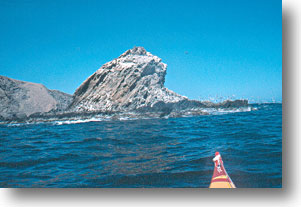
By evening when we arrived at Western River Cove we had the Sun full in our faces, making for uncomfortable paddling. It was dark when tea was finished, so the washing up was left until morning. Our fourth day was a very easy one, moving along with the tide in almost calm conditions. We passed Snug Cove. There, at the top of a pinnacle was an eagle’s nest, with one of its owners watching us through a veritable cloud of terns. [Picture]
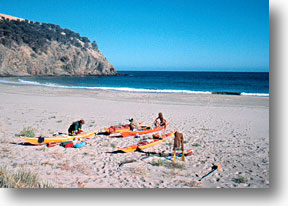
We landed at Kangaroo Gully and spent the afternoon drying out some gear. [Pic shows prelaunch next morning] Making the first days of an expedition fairly easy allows things like not quite waterproof packing to be found and corrected before they become real problems. One problem that David found was a gremlin in his SLR camera. That was something we couldn’t fix. He went fishing, but caught rock cod only and threw them back. John spent some time working on a loose paddle blade. We saw no kangaroos, only a large billygoat.
Christmas Day dawned fine and clear and we made good speed again to Harvey’s Return. There we found ourselves with another rocky beach instead of the sand we had expected. Some local people came down in the afternoon and were also surprised to find no sand, which normally appears in summer and washes away each winter.
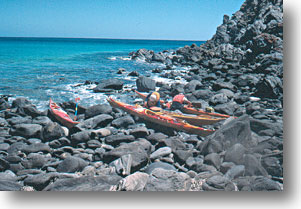
Harvey’s Return had been the landing for the materials of the nearby Cape Borda lighthouse, and on the shore is the concrete base for the crane used to unload it all. The nearby rocks would keep geologists happy for some while collecting specimens of their intricately folded strata. This time David’s fishing was more successful, and the sweep he caught were a special addition to Christmas tea, cooked in foil with spices.
We were now at the end of the sheltered north coast of the island. We had seen the occasional big swell passing, but seas had been small, and except for one day we had been sheltered from the wind. The north coast has numerous small coves, only few of which we had actually used. Paddling had been easy. From now on we would face open ocean.
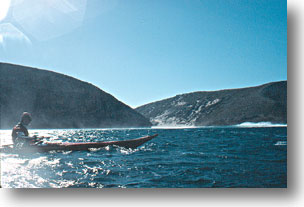
The wind was picking up as we rounded Cape Borda next morning, and the occasional gust made paddling awkward. We wondered whether it would be possible to land at Ravine des Casoars, but one look at the swell dumping on the beach showed that it wasn’t. [Picture: Dave at left] We continued, passing a fishing boat which reported our position and gave us more advice on approaching West Bay, to which we were now heading.
Landing at West Bay was not without its drama. We had been advised to approach the northern part of the beach, but it all looked the same to us as we surfed in. Mike managed to loop his boat through the break, showing us his stern in the air, inverted.
West Bay is within Flinders Chase and is a popular spot for tourists, and before long the four small boats on the sand were being inspected by both visitors and local people. The bay is also used by fishing craft as an anchorage, as it is sheltered from all directions except the west.
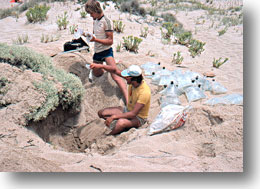
The forecast for the next day was doubtful, of another change coming, and when we awoke cloud was building up and moving rapidly southwards, although the surf was low. We decided to stay. In any case, there was food and water to retrieve from its hiding place in the sand. Instead of paddling, we spent the day digging [Mike and Dave in the picture], fishing, drying out a wet radio or exploring, and John went diving with some borrowed gear. He brought up some abalone for supper, but was disappointed that he had been unable to catch the crayfish he had seen. The weather turned out to be superb.
Mosquitoes were the main distraction of the night, but the day dawned overcast, drizzling and with strong winds. We stayed again. The ABC News reported us as being ‘in high spirits’ but in reality we were frustrated, especially in view of more Strong Wind Warnings.
The news next morning reported a yacht in difficulties in rough seas in Backstairs Passage and having to be towed to Kingscote. The weather remained doubtful, so we stayed again. One of our visitors that day was a descendant of someone in the last century who, evading the law in Melbourne, had lived at West Bay and trapped possums for their skins. To send them off to Port Adelaide he had rowed single handed out to stop passing ships. Our visitor himself had paddled a homemade canoe off Kangaroo Island beaches, usually to be swamped by the first wave, and was interested to compare his craft with our Nordkapps.
The Nordkapp is no newcomer to the sea expedition scene. It was designed in l974, derived from a Greenland original, to make an expedition to Nordkapp, the northernmost point of Europe. Since then Nordkapps have been around Cape Horn, Britain, New Zealand, Tasmania and many other places6. To turn the wheel full circle, some have been used by Inuit on Baffin Island. A Nordkapp is 5.5 m long and 55 cm beam, is reasonably fast, very seaworthy, but a little ‘tippy’ unless loaded. Ours had the now usual systems of bulkheads and hatches, cockpit pumps, spare paddles and various emergency equipment.
‘Yahoo! We made it Dave!’ was Mike’s comment as we broke through the surf next morning. As it turned out, that would have been a better remark for the end of the day, but we were pleased to have better weather at last and headed towards Cape du Couedic.
As we headed south, dolphins beneath us at one stage, and birds above, Mike was quietly sinking. His bow dipped lower and lower so that he was finally going through, rather than over the waves, and the boat was becoming slower and progressively less stable. The most likely cause of the trouble was the hatch, which would now have to be opened to allow the compartment to be pumped put. We rafted up. Despite our efforts the hatch refused to budge. I could see no option but to use more force, so began striking it with a hatch lever and a flare tube as a mallet, much as I had done before with tight hatches. This one still refused to unscrew. I struck harder, and the retaining ring of the hatch broke.
Now the hatch was really off. Pumping out was no great problem, securing it again was. Like all good ideas, the solution was simple: we wrapped tape right around the boat and over the hatch. The hatches wece originally designed for occasional use on lifeboats, not for the use, and abuse, they must withstand on sea kayaks. There is clear potential for someone inventive to produce a simpler, more rugged, and therefore more reliable one7.
Critics would argue that the event was extremely hazardous, a good reason for us not to be allowed to be where we were, several kilometres off one of the most inhospitable coasts in South Australia. Yes, it was a tense moment, but I consider the hazard more apparent than real. One doesn’t take a sea kayak into open water unless he knows how to make it work even when things are going wrong. This means both paddling and ‘engineering’ skills, and between the four of us there was no shortage of either. Even if we had completely lost the boat at that point we could all have returned to shore, albeit not comfortably. I was once in a group forced to land with a swamped boat in rough conditions, and at least one kayak has been broken apart off Tasmania, but its owner continues to enjoy his sea kayaking8. There are risks certainly, that is part of the challenge of sea kayaking, but they are risks that can be overcome.
Tentatively at first, we moved on.
Our immediate problem was to land and ensure that the repair was holding. The next step was to obtain a replacement. I’m not sure what the others were thinking, but my own idea was to get to a telephone and call the supplier, or to send a written message, and ask for one to be sent. I knew exactly what was needed and where it was to be found, and wanted to avoid the possible confusion that can happen with verbal messages.
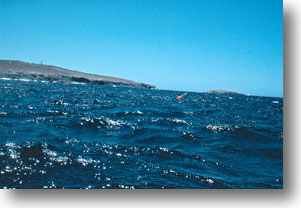
Feeling more confident as time went on, we passed Cape du Couedic [Picture], meeting a fishing boat. I mentioned that we were having hatch problems. ‘What’s a hatch?’ asked the skipper and I pointed to the one on my own deck. The nearest landing was near Remarkable Rock, and now it was my turn for a spectacular arrival. The landing technique in surf is to approach behind a breaking wave, but while waiting outside the break I turned to find a wave about to break on top of me. I was churned ashore inverted.
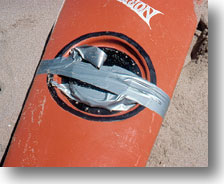
Mike’s boat was still dry, so, relieved, we closed it up again with more tape and some wet suit cement and launched again. I was nearly dumped again on the way out. [Below: Dave Nicolson off Kirkpatrick Point—not the averge tourist’s view of Remarkable Rock]
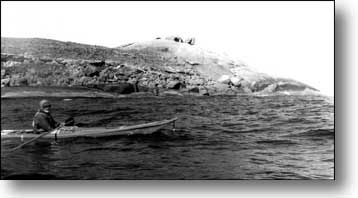
By comparison, our landing at South West River was serene. There on the beach was an amiable fellow calling ‘Like a beer?’ and inviting us up to tea on fresh whiting. The fish were delicious, but the place felt peculiar. We all remarked afterwards that the table seemed to have been moving with the swells.
After tea I was driven to the nearest telephone. On calling the radio network I was told that a new hatch would be delivered by helicopter the next morning. The fisherman had radioed the news of our trouble, and there had been innumerable phone calls to locate the supplier. When he learned the news he had had the bright idea of taking it to a television station. They would have a story and we would have our hatch9.
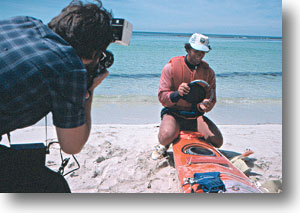
We played Frisbee next morning as almost the whole population of South West River waited for the helicopter, and in due course the journalists had their story and Mike’s boat was complete again. The strongest wind we had that day was the helicopter’s downwash as it circled for pictures.
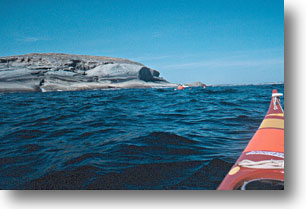
In the calm we continued to Vivonne Bay, the largest settlement on the south coast. Almost the entire shore was rock, some of it rounded granite outcrops [Cape Kersaint in picture]. Big swells rolled by.
At Vivonne Bay we had more food stored and there had been some concern at to what might have to be left behind. ‘The mouse has decided for us,’ complained Mike as he inspected the bags, all sampled by a determined rodent. Only one package was untouched: the cheese!
We set out in the morning in very doubtful conditions, but soon returned. The weather was obviously not going to improve. We were making very slow progress in heavy conditions and could not be sure of safe landing along an exposed coastline, and decided to return to where we knew we had shelter, communication and supplies. For the next seven days, as we grew increasingly despondent, the forecasts contained Strong Wind Warnings. On several days not even the professional fishermen ventured out. Elsewhere, there were storms in Melbourne and heats of sailing championships were abandoned off Adelaide. We spent our time exploring, fishing, talking to people and trying to deter the neighbouring possum and penguins. As the week wore on the tidal range increased and we had to move higher on the beach. Someone asked ‘When are you fellows going to start paying rates?’
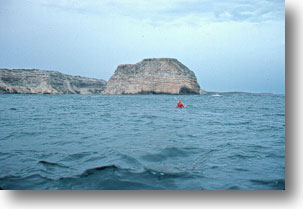
The sky was overcast when we set out again, but the wind was less than 15 kn at last. Almost nonstop we paddled, past Nobby Islet, Seal Bay and Cape Gantheaume, perhaps the most inaccessible part of the island, until we flopped on to the seaweed at D’Estrees Bay. Twenty seven nautical miles (51 km) after a week’s rest has its repercussions, but with virtually no intermediate landings possible the stage had to be done without a break.
We made a slow start the next morning in light northerly winds, but with a change forecast, and stopped for lunch at Point Reynolds. By mid afternoon, we were all fairly tired and the others contemplated landing at Mouth Flat Beach, the mouth of Willson River, a steep little beach with non-stop dumpers. I pointed out that Pink Bay, sheltered and with access to telephone, was within reach and that we should make the effort in the conditions we then had. We pressed on, with following winds and seas along a forbidding coast.
Somewhere between Cape Hart and Cape Willoughby we were passed by a fishing boat, whose skipper threw us a bottle of orange cordial, cold from his refrigerator. For a moment it was like playing canoe polo to pick it up, not that the Nordkapp is much of a polo boat. Refreshed, we continued, with the sky now clouding over. Thunderstorms were rumbling over the distant mainland and it was raining by the time we passed the easternmost point of Kangaroo Island, the granite cliffs of Cape Willoughby, and arrived in Pink Bay. There we found two fishing craft, and before long our position had been reported to the world.
We now knew that we had completed the most arduous part of the journey. From Pink Bay on we would be on the north coast again, sheltered from the worst effects of wind and sea. Next day we left about midday for an easy passage to Penneshaw where we were in ‘civilization’ again. After the weeks of solitude, it was now 21 days since we had set out, the after cricket crowd in the hotel was a trauma. That night the news had us in Penneshaw after paddling 100 nautical miles in two days. In reality, we had travelled 72 nm (134 km) in three days. Someone had misread his map scales.
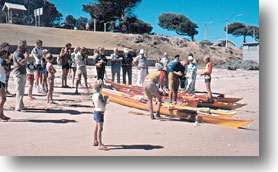
After a night in Penneshaw we moved on around to American Beach to stay with some diving friends before the final leg to Kingscote. That was an easy stage, with following wind and sea. We sat down to tea that night in the hotel, after a welcome by the mayor, a very relieved police sergeant, tourists, and more helicopter commuting journalists. Their report the next morning contained factual inaccuracies and had my name wrong again. My confidence in journalists sank to nil.
The return to Adelaide that night by MV Troubridge felt a little odd. After looking up to waves for so long we now looked down on the sea. Mike and David returned to work, but John and I checked our boats and equipment for the next expedition.
Notes
1 Where are we now? I left the Education Department several years ago and work freelance. David is still with Thor-Paddy Pallin. John Hicks I have not seen or heard of for some years, but he is now living in the Adelaide Hills. Mike worked for a time at West Lakes Aquatic Centre, then moved back to Victoria to work with the Victorian Board of Canoe Education. He later moved to Sydney where I met him at several Aus Board of Canoe Education meetings. Mike was more recently in charge of the Skills Recognition proces through Regency TAFE for the new Aus Canoeing Award Scheme. As of early 2008 he and his partner were working in Morocco with the International Red Cross.
2 The first kayak expedition to the Sir Joseph Banks Group in September 1978.
3 We carried small AM radios and listened to forecasts with ABC news broadcasts. We soon discovered that forecasts were few and far between on weekends and public holidays.
On later expeditions I carried a Sony ICF-Pro80 and listened to the Small Ships broadcasts on the OTC HF network. When Adelaide Radio closed we were without ready access, as reception of Melbourne Radio was much less reliable.
These days, some of us carry marine VHF for the Coastguard network. Reception is not as good as the old HF network, but we now have two-way communications.
4 As Australia Pilot says (p 12) ‘There is a tendency along the coast for winds between S and E to predominate in summer...’ because Highs form and remain in the Bight. Add the sea breeze and winds of 20 kn plus are common. A better time for expeditions such as these is March–April.
5 Adelaide’s daily, The Advertiser. At the time I was writing a monthly canoeing column for the boating section.
6 Paul Caffyn used a Nordkapp on his 1982 circumnavigation of the continent. At the time the Nordkapp was virtually the only expedition-rated sea kayak commercially available in Australia. Mine was built in January 1978 and is still in service. (See Notes for more detail)
7 The better hatch system came from the Nordkapp’s designer, Frank Goodman: the VCP hatch. The cover is moulded in synthetic rubber. I fitted a pair as soon as they became available. Both the VCP product (now in two sizes) and its clones are regarded as the most secure kayak hatches.
8 A kayak has now been broken in two off the SA West Coast. In April 2000 David Williamson’s Raider-X was broken apart in a big wave, another boat was badly damaged, and the group made a forced landing with David on a kayak raft and the remains in tow.
9 The supplier was Joe Lamb, Valley Canoe Products licencee in Australia. I’m not sure if it was his idea to send it by helicopter, or that of Grant Cawthorne, who was visiting Joe at the time. Whichever, the idea was a good one, bringing us the replacement quickly, and some publicity.